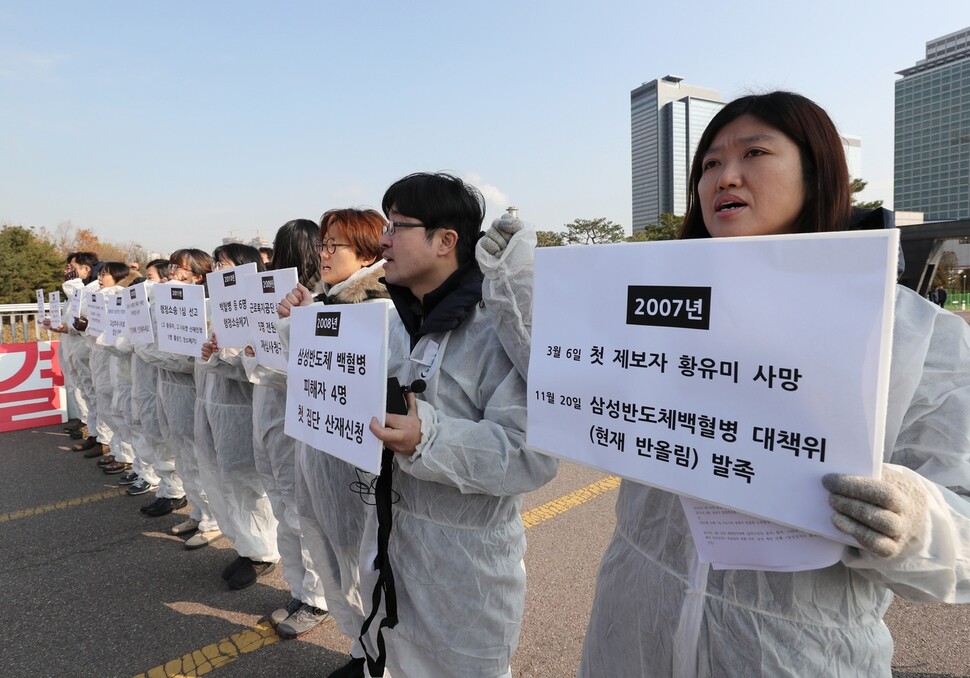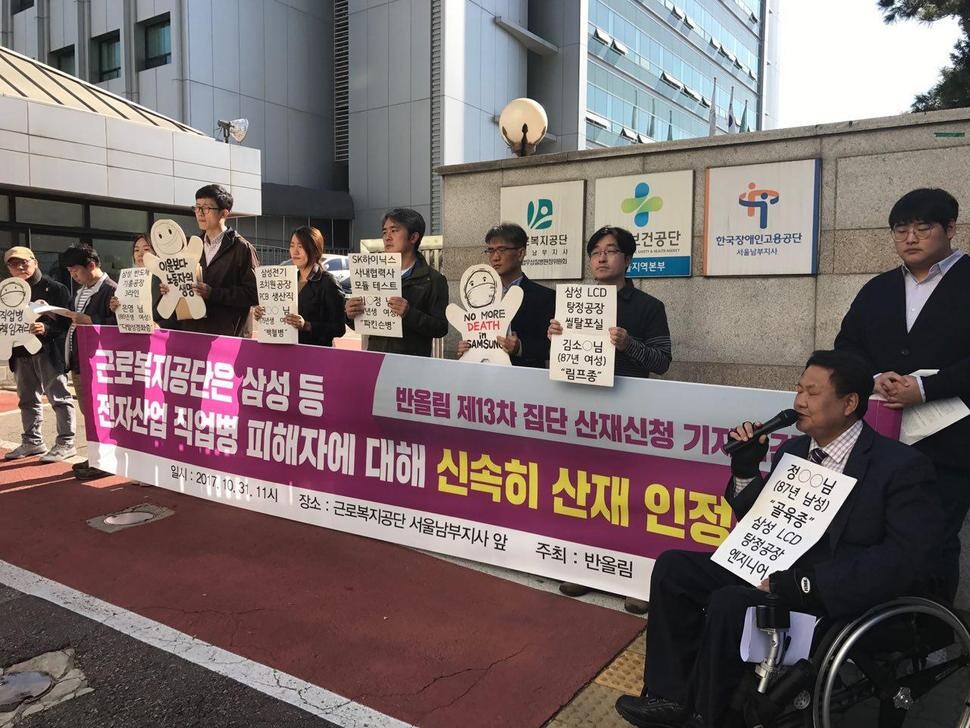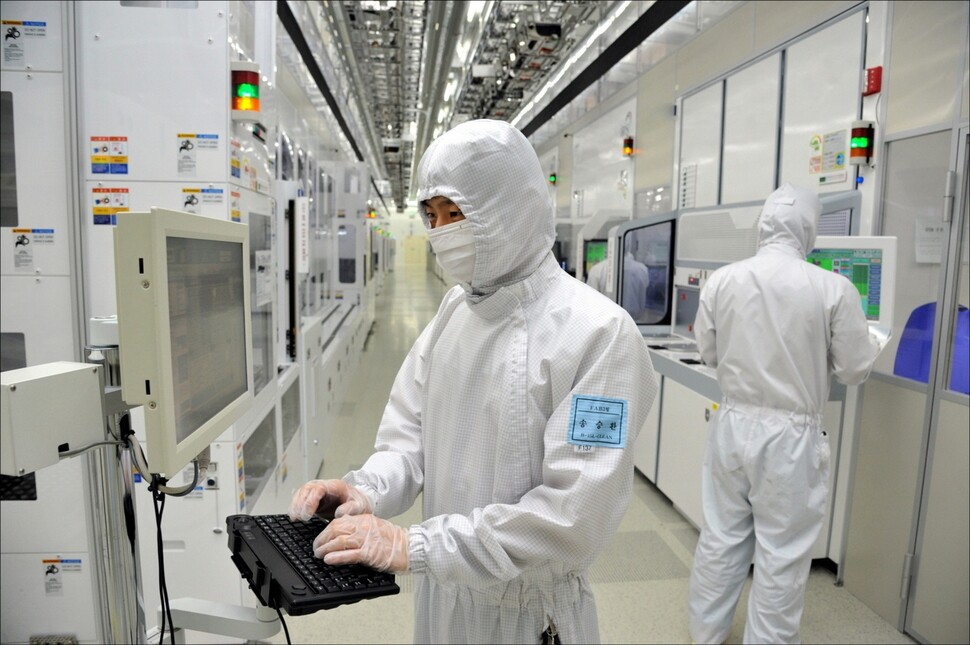hankyoreh
Links to other country sites 다른 나라 사이트 링크
10 year struggle of Banollim for semiconductor workers’ health and human rights

“We’re still on the streets. Samsung needs to resolve the issue of occupational diseases!” The cry that filled the air in front of the entrance to Samsung Digital City in Suwon on the morning of Nov. 20 was enough to distract one from the cold spell that had struck so unexpectedly. It was a cry demanding recognition of the industrial accidents that had befallen workers at semiconductor plants and fair compensation for those workers.
During a press conference, activists from more than 100 groups – including Banollim, a watchdog group defending the health and human rights of semiconductor plant workers, as well as progressive political parties, organized labor, civic groups and human rights groups – urged Samsung to take action to take part in dialogue and resolve the problem. In the words of the activists, “Samsung must no longer ignore the death of its workers.” This day marked the 10th anniversary since Banollim was established. It was also the 776th day since the group launched an outside sit-in in front of the corporate headquarters of Samsung Electronics near Gangnam Station in Seoul.
In March 2007, Hwang Yu-mi, a former worker at a Samsung Electronics factory in Giheung, died of leukemia. That June, Hwang’s bereaved family members applied to the Korea Workers’ Compensation and Welfare Service (KCOMWEL) for industrial accident compensation. This industrial accident claim, which was the first for a semiconductor plant employee, was rejected on the grounds that “the causal relationship between work and disease was not established.”
On Nov. 20 of that year, a group was established called the Joint Action Committee for Learning the Facts about the Outbreak of Leukemia at Samsung Semiconductors and for Securing the Basic Rights of Labor, with the involvement of 19 labor and civic groups. As of the group’s founding, Hwang’s family members were still the only victims that had applied for industrial accident compensation for a semiconductor worker. But after a string of cases of workers getting sick or dying not only at Samsung semiconductor plants but also at plants run by other companies, the action committee changed its name to Watchdog for the Health and Human Rights of Semiconductor Workers and launched its campaign to learn the truth about occupational diseases and industrial accidents in the semiconductor industry and to provide workers with compensation.
According to Banollim, 393 workers in South Korea’s semiconductor industry have reported coming down with occupational diseases over the past decade, and 144 of them have already lost their lives. There have been 320 reports of disease and 118 deaths at Samsung affiliates alone – such as Samsung Electronics, Samsung Electro-Mechanics and Samsung SDI – accounting for 80% of the total.
Nevertheless, the rate at which their medical conditions have been officially recognized as industrial accidents is extremely low. Thus far, Banollim says, 94 individuals have submitted industrial accident claims to KCOMWEL, but only 12 of them have received recognition for their conditions from the agency. 25 of those individuals whose claims were rejected have filed administrative lawsuits, of which 10 have received judgments confirming the industrial accident. Most of the others are in the middle of a long and challenging “struggle for recognition,” in which they must prove the causal relationship between their work and their disease.

The most common disease listed on the industrial accident claims is leukemia, reported by 22 individuals, followed by breast cancer (12), non-Hodgkin lymphomas (10), brain tumors (9), lung cancer (6), aplastic anemia (5) and multiple sclerosis (4). Workers in the semiconductor field also suffer from a variety of uncommon diseases, such as thyroid cancer, ovarian cancer, osteosarcoma, myelodysplastic syndrome, Parkinson’s disease and amyotrophic lateral sclerosis, also called Lou Gehrig’s disease.
“These workers spent their youth in a constant battle with the disease, and it ended terribly. They have either met a painful death or another kind of suffering in the form of continuing trauma,” Banollim said in a statement during the press conference. “What has been even more infuriating for these victims of occupational diseases is to see Samsung so ruthlessly disregarding their pain.”
It still needs to be determined whether these illnesses are actually the result of working at semiconductor factories. But that is exactly why Banollim is calling for an objective and credible investigation into their conditions, and furthermore for a recognition of responsibility based on court decisions. Samsung, however, has not only disregarded the issue of these occupational disease, dismissing them as being “personal conditions that are unrelated to work,” but furthermore “will not acknowledge responsibility for occupational diseases even if they have later been acknowledged as industrial accidents by KCOMWEL and the courts.”
According to a Nov. 19 report by Sisa Journal, the sixth administrative division of the Seoul Administrative Court ruled on Nov. 17, in favor of the plaintiffs in a lawsuit brought by the bereaved family of Son Gyeong-ju (a worker with a subcontractor for Samsung Electronics). Son’s family want KCOMWEL to pay survivor benefits and funeral expenses.

From Jan. 2003 to Oct. 2004, Son worked for an equipment maintenance and repair subcontractor as the on-site supervisor at the Hwaseong factory of Samsung Electronics. After that, and until May 2009, Son worked as the on-site supervisor for another subcontractor at the company’s Giheung Factory until he contracted acute lymphoblastic leukemia. Treatment for the disease was initially effective, but it returned in Jan. 2012, and Son passed away seven months later. In July 2013, Banollim filed a group industrial accident claim for Son and nine other semiconductor workers.
The judge for the lawsuit filed by Son’s family was convinced by the family’s argument that “for about eight hours a day, Son made the rounds to do safety inspections or stayed in the cleaning room at the semiconductor factory. During this process, he was exposed to harmful chemicals for a long period of time, which caused the disease.” This decision is noteworthy since it is the first one that recognizes the connection between a disease and work for a manager, and not for a worker or engineer who were directly handling parts on a semiconductor factory’s assembly line.
By Cho Il-jun, staff reporter
Please direct questions or comments to [english@hani.co.kr]

Editorial・opinion
![[Column] Is Korean democracy really regressing? [Column] Is Korean democracy really regressing?](https://flexible.img.hani.co.kr/flexible/normal/500/300/imgdb/original/2024/0705/2917201664129137.jpg) [Column] Is Korean democracy really regressing?
[Column] Is Korean democracy really regressing?![[Column] How tragedy pervades weak links in Korean labor [Column] How tragedy pervades weak links in Korean labor](https://flexible.img.hani.co.kr/flexible/normal/500/300/imgdb/original/2024/0703/8717199957128458.jpg) [Column] How tragedy pervades weak links in Korean labor
[Column] How tragedy pervades weak links in Korean labor- [Column] How opposing war became a far-right policy
- [Editorial] Korea needs to adjust diplomatic course in preparation for a Trump comeback
- [Editorial] Silence won’t save Yoon
- [Column] The miscalculations that started the Korean War mustn’t be repeated
- [Correspondent’s column] China-Europe relations tested once more by EV war
- [Correspondent’s column] Who really created the new ‘axis of evil’?
- [Editorial] Exploiting foreign domestic workers won’t solve Korea’s birth rate problem
- [Column] Kim and Putin’s new world order
Most viewed articles
- 1Beleaguered economy could stymie Japan’s efforts to buoy the yen
- 2[Column] Is Korean democracy really regressing?
- 3What will a super-weak yen mean for the Korean economy?
- 4South Koreans living near border with North unnerved by return of artillery thunder
- 5National Assembly passes bill for special counsel probe into Marine’s death
- 6[Column] How tragedy pervades weak links in Korean labor
- 77 in 10 Koreans report experiencing mental health issues, a rising trend
- 810 days of torture: Korean mental patient’s restraints only removed after death
- 9Car behind deadly crash began rapid acceleration after exiting underground garage
- 10Shoddy records help Korean hospitals conceal abuse of mentally ill